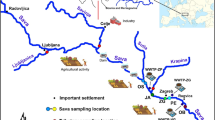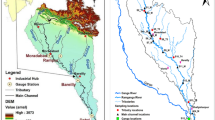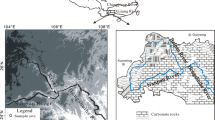Abstract
The dissolved load of the Amazon River is generally considered to be lowly impacted by anthropogenic activities. In this work, based on the chemical and hydrological database of the Environmental Research Observatory—HYBAM (http://www.ore-hybam.org), we explore the importance of the Peruvian Foreland petroleum activity on the dissolved Na and Cl fluxes of the Amazon River. The main result of this study allows us suggesting that oil extraction activity, concentrated in the El Tigre River basin, a small foreland watershed in the Peruvian Amazon, influenced drastically the Na and Cl exportation of the Amazon River during the 2006–2007 period. During these years, the dissolved exportations of this basin represented almost 20 % of the annual dissolved Cl Amazon flux and almost 12 % of the annual dissolved Na Amazon flux for a mean annual discharge <1 % of the Amazon River discharge. Since the last decades, the anthropogenic activities are increasing over the whole Amazon basin, especially in Andean countries. In this context, our results demonstrate that extractive activity cannot be considered as negligible on the hydro-chemistry of the Amazonian Rivers especially for the weathering budget estimation based on river-dissolved loads. Moreover, Cl and Na can be used to trace the formation waters derived from oil extraction at a large spatial scale. The environmental impacts of contaminants associated with deep water released to the hydrosystem (polycyclic aromatics hydrocarbons, metallic trace elements, etc.) at local and regional scales are still underestimated and should be monitored to map their local and regional influence and to prevent their risks on human health.






Similar content being viewed by others
References
Benavides V (1968) Saline deposits of South America. Geol Soc Am 88:249–290
Bernal C, Christophoul F, Darrozes J et al (2010) Late Glacial and Holocene avulsions of the Rio Pastaza Megafan (Ecuador–Peru): frequency and controlling factors. Int J Earth Sci 100:1759–1782
Biggs TW, Dunne T, Domingues TF, Martinelli LA (2002) Relative influence of natural watershed properties and human disturbance on stream solute concentrations in the southwestern Brazilian Amazon basin. Water Resour Res 38:25–1–25–16
Bouchez J, Gaillardet J, Lupker M et al (2012) Floodplains of large rivers: weathering reactors or simple silos? Chem Geol 332–333:166–184
Callède J, Ronchail J, Guyot JL, De Oliveira E (2008) Déboisement amazonien: son influence sur le débit de l’Amazone à Óbidos (Brésil). Rev Sci Eau 21:59–72
Cañedo-Argüelles M, Kefford BJ, Piscart C et al (2013) Salinisation of rivers: an urgent ecological issue. Environ Pollut 173:157–167
Espinoza Villar J-C, Ronchail J, Guyot J-L et al. (2009) Spatio—Temporal rainfall variability in the Amazon basin countries (Brazil, Peru, Bolivia, and Ecuador). Int J Climatol 29:1574–1594
Finer M, Jenkins CN, Pimm SL et al (2008) Oil and gas projects in the Western Amazon: threats to wilderness, biodiversity, and indigenous peoples. PLoS One 3:e2932–1–e2932–9. doi:10.1371/journal.pone.0002932
Finer M, Moncel R, Jenkins CN (2010) Leaving the oil under the Amazon: Ecuador’s Yasuní-ITT Initiative. Biotropica 42:63–66
Finer M, Jenkins CN, Powers B (2013) Potential of best practice to reduce impacts from oil and gas projects in the Amazon. PLoS ONE 8:e63022
Finer M, Orta-Martinez M (2010) A second hydrocarbon boom threatens the Peruvian Amazon: trends, projections, and policy implications. Environ Res Lett. doi: doi:10.1088/1748-9326/5/1/014012
Fritsch JM (1986) L’augmentation du ruissellement après défrichement mécanisé de la forêt amazonienne. Société Hydrotechnique de France, Paris
Gaillardet J, Dupré B, Allègre C-J, Négrel P (1997) Chemical and physical denudation in the Amazon River Basin. Chem Geol 142:141–173
Gutierrez Choquevilca A-L, Huboux E (2006) Exploitation pétrolière et dynamique des territorialités indiennes dans la région du haut Pastaza péruvien. M@ppemonde 82. http://mappemonde.mgm.fr/num10/articles/art06205.pdf
Hurtig A-K, San Sebastián M (2002) Geographical differences in cancer incidence in the Amazon basin of Ecuador in relation to residence near oil fields. Int J Epidemiol 31:1021–1027
Hurtig A-K, San Sebastián M (2004) Incidence of childhood leukemia and oil exploitation in the Amazon basin of Ecuador. Int J Occup Environ Health 10:245–250
INGEMMET (1999) geological maps, scale 1:100,000. INGEMMET-Instituto Geologico y Metalurgico del Peru
Markewitz D, Davidson EA, Moutinho P, Nepstad DC (2004) Nutrient loss and redistribution after forest clearing on a highly weathered soil in Amazonia. Ecol Appl 14:177–199
Maurice-Bourgoin L, Quiroga I, Guyot JL, Malm O (1999) Mercury pollution in the upper Beni River, Amazonian basin: Bolivia. Ambio 28:302–306
Meybeck M, Helmer R (1989) The quality of rivers: from pristine stage to global pollution. Palaeogeogr Palaeoclimatol Palaeoecol 75:283–309
Ministerio de Energia y Minas-MINEM (Peru) - Direccion General de asuntos ambientales - ECOTEC/FLUOR DANIEL GTI (1998) Evaluacion ambiental territorial de las cuencas de los rios Tigre-Pastaza. Report of MINEM-Peru. Lima
Molinier M, Guyot JL, de Oliveira E et al (1993) Hydrologie du bassin de l’Amazone. Actes du Colloque Grands Bassins Fluviaux péri-atlantiques: Congo, Niger, Amazone. PEG/INSU/CNRS/ORSTOM, Paris (France), pp 335–344
Moquet J-S, Crave A, Viers J et al (2011) Chemical weathering and atmospheric/soil CO2 uptake in the Andean and Foreland Amazon basins. Chem Geol 287:1–26
Mortatti J, Probst J-L (2003) Silicate rock weathering and atmospheric/soil CO2 uptake in the Amazon basin estimated from river water geochemistry: seasonal and spatial variations. Chem Geol 197:177–196
Orta Martınez MO, Napolitano DA, MacLennan GJ et al (2007) Impacts of petroleum activities for the Achuar people of the Peruvian Amazon: summary of existing evidence and research gaps. Environ Res Lett 2:10
Reyes F, Ajamil C (2005) Petróleo, Amazonía y capital natural. Fondo Editorial C.C.E, Quito
Roddaz M, Viers J, Brusset S et al (2006) Controls on weathering and provenance in the Amazonian foreland basin: insights from major and trace element geochemistry of Neogene Amazonian sediments. Chem Geol 226:31–65
Roulet M, Lucotte M, Canuel R et al (1998) Distribution and partition of total mercury in waters of the Tapajós river basin. Braz Amazon Sci Total Environ 231:203–211
Salvarredy-Aranguren MM, Probst A, Roulet M, Isaure M-P (2008) Contamination of surface waters by mining wastes in the Milluni Valley (Cordillera Real, Bolivia): mineralogical and hydrological influences. Appl Geochem 23:1299–1324
San Sebastián M, Hurtig A-K (2004) Oil exploitation in the Amazon basin of Ecuador: a public health emergency. Rev Panam Salud Publica 15:2004
San Sebastián M, Armstrong B, Córdoba JA, Stephens C (2001) Exposures and cancer incidence near oil fields in the Amazon basin of Ecuador. Occup Environ Med 58:517–522
San Sebastián M, Armstrong B, Stephens C (2002) Outcomes of Pregnancy among women living in the proximity of oil fields in the Amazon basin of Ecuador. Int J Occup Environ Health 8:312–319
Smith LR (1989) Regional variations in formation water salinity, Hollin and Napo formations (Cretaceous), Oriente Basin, Ecuador. Am Assoc Petrol Geol Bull 73:757–776
Stallard RF, Edmond JM (1983) Geochemistry of the Amazon. 2. The influence of geology and weathering environment on the dissolved load. J Geophys Res 88:9671–9688
Uhl C, Jordon CF (1984) Succession and nutrient dynamics following forest cutting and burning in Amazonia. Ecology 65:1476–1490
Vauchel P (2005) HYDRACCESS: software for management and processing of hydro—meteorological data. www.mpl.ird.fr/hybam/outils/hydraccess
Vinson DS, Bonzongo JC, Lyons WB et al (1997) Gold-mining and mercury pollution in the Amazon river system, Brazil: Hg level in surface waters of the Madeira rivers from Porto Velho to the confluence with the Amazon river. EOS Transactions, American Geophysical Union, 1997 Fall meeting 78: F199
Williams MR, Melack JM (1997) Solute export from forested and partially deforested catchments in the central Amazon. Biogeochemistry 38:67–102
Acknowledgments
We specially thank Julien Bouchez for his constructive recommendations under the review process. This work was funded by the French Institut de Recherche pour le Développement (IRD), the French Institut des Sciences de l’Univers (INSU) and the Observatoire Midi-Pyrénées through the ORE HYBAM Observatory. A special thank is dedicated to the local people who realized the water sampling and filtrations and the water level measurements. We gratefully thank Pascal Fraizy, Philippe Vauchel, William Santini, Francis Sondag and Alain Plenecassagne from the IRD’s team of the ORE-HyBAm, the SENAMHI (Servicio Nacional de Meteorología e Hidrología—Lima Peru), the INAMHI (Instituto Nacional de Meteorología e Hidrología—Quito Ecuador), the UNALM (Universidad Nacional Agraria de La Molina, Lima—Peru), all members of the Observatory for Environmental Research HYBAM (Hydrogeodynamics of the Amazon basin), for providing hydrological and water chemistry data and Guillaume Bertrand for his advices on statistical calculations.
Author information
Authors and Affiliations
Corresponding author
Rights and permissions
About this article
Cite this article
Moquet, JS., Maurice, L., Crave, A. et al. Cl and Na Fluxes in an Andean Foreland Basin of the Peruvian Amazon: An Anthropogenic Impact Evidence. Aquat Geochem 20, 613–637 (2014). https://doi.org/10.1007/s10498-014-9239-6
Received:
Accepted:
Published:
Issue Date:
DOI: https://doi.org/10.1007/s10498-014-9239-6




